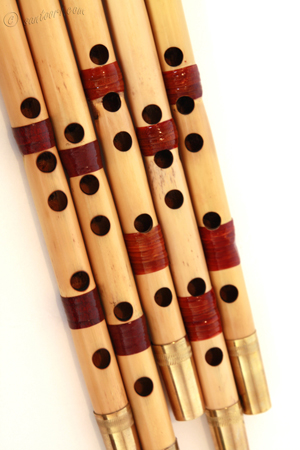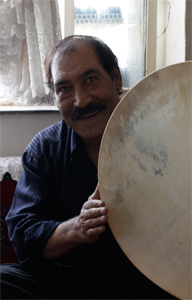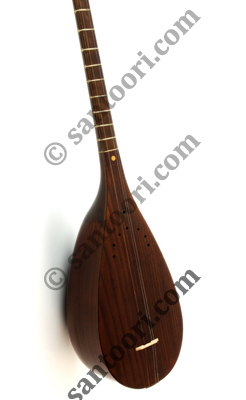|
|
Iranian tar | Persian tar
|
![Iranian tar | Persian tar [Persian long necked plucked lute]](images/iranian%20musical%20instruments/tar_photo_santoor_web.jpg) |
Tar is the double-chested plucked lute with a membrane as a sound-box,
found in Iran and the Caucasus. It exists in two forms, the Persian and
the Azerbaijani or Caucasian. [In Persian language tār-e Shiraz and/or
tār-e Qafqāz].
Persian tar is more associated with Persian art music, especially after
its popularity thru such 19th-century performers as Ali-Akbar Farahani,
Mirza Hosseynqoli etc….
The Persian tar is carved from a block of mulberry wood and has a deep,
curved Body with two bulges shaped like a figure 8. The upper surface is
shaped like two hearts of different sizes, joined at the points (see
Illustration). The timber nasality of Persian tar is because of the
lamb's fetus skin used for the soundtable. On the lower skin a horn
bridge supports six metal strings in three courses, tuned c'/c' - g/g -
c/c'. The strings are plucked with a brass plectrum coated in wax,
making possible both subtlety and virtuosity in the playing technique.
The long neck has a fingerboard covered with camel leg bone. Based on
performer style, there are movable gut frets from 22 to 27 on the
fingerboard; accordingly the octave will be divided from 15 to 17
microtonal intervals.
The Caucasian tar (tār-e qafqāzi) is differentiated from the Persian by
its shallower, less curved body. The Caucasian instrument has a wider
neck and bridge than the Persian, and usually has 22 gut frets. These
can be adjusted to produce microtonal intervals for traditional mugam
performance or to the 12-note tempered scale. The membrane, usually made
of the pericardium of a bullock, is thicker than the Persian type. The
strings are plucked with a plectrum usually made of Bakelite or similar
hard, synthetic material, or in rare cases of bone. The timbre is harder
and drier. It is held almost horizontally against the upper chest, and
the performer shakes the tar slightly to produce a vibrating sound. The
Caucasian tar is highly esteemed in Azerbaijan and Armenia. It is
sometimes found among the Turks of Khorasan and in Uzbek and Tajikistan,
where it is played in ensemble and, in the Shirvani style of epic
performance, by bakhshis, and has also been introduced in Turkey. |
|
|
|
|
|
Iranian Ney | Persian Ney
|
 |
Ney
with different transcription and transliteration forms like nai and nay
refers to various oblique rim-blown flute of Iran, Turkey and some
central Asian countries. The term derives from the old Persian for
'reed' or `bamboo' and by extension 'reed flute'.
The instrument has been known in the Near East since antiquity;
iconographic and written documents attest its use by the ancient
Egyptians in the 3rd millennium BCE. A Sumerian silver flute dating from
2450 BC has been found in the royal cemetery of Ur in Southern
Mesopotamia.
Persian ney
or the ney of Iran is primarily a classical instrument; it is made of a
seven-segment section of reed with six nodes, 40 to 80 cm long, and has
five finger-holes and one thumb-hole producing the basic pitches c', d',
e', f , f#', g', a' (the e and a are a quarter-tone flat). Musicians
often use different sizes of ney during a concert. The missing notes can
be obtained by varying the breath pressure, and the range can thus be
extended to two and a half octaves.
A virtuoso can play the three-octave range an one instrument by altering
the position of his fingers on the holes, by movements of the lips and
head, and by breath control.
As the bevelled edge of the mouth-hole is sharp on the inside, it is
often covered by a metal band to prevent damage to the instrument. The
Joints are sometimes made at the nodes of the reed, the tube of which
can be decorated with engraving.
The reed pipe from which the instrument is made should be not less than
three years old and the tube must be hard, smooth and Compact; the
distance between the nodes is taken into consideration.
Persian ney
Players
place the rim between their teeth, which produces a warmer and more
powerful tone; The ney is the only wind instrument in the classical
Persian orchestra, but its melodic and rhythmic resources fit it equally
for solo performance.
Various popular forms of the
Iranian ney
are known, made of wood, reed or metal and with various vernacular
names, for example the
Baluchi nel,
Turkmen tüydük
and
Kurdish
shimshal.
|
|
|
|
|
|
Kurdish
Daf | Iranian Daf | Persian Daf
|
 |
Daf with its different transcription and transliteration forms like
Daff, dap, def, deff, defi, diaff, duff, refers to round single-headed
frame drum connected with oriental cultures.
The drum had
been widely used in Folk and entertainment music. In Turkey, Syria,
Iraq, Iran and elsewhere it has historical and contemporary associations
with Sufi rituals. In varying forms it is found in West Asia, the
Caucasus, the Iranian plateau, Central Asia and south-eastern Europe.
The drum is used in a wide variety of settings: folk music, art music,
entertainment and dance music and Sufi religious rituals.
Kurdish type of frame drum is historically related to the pre-Islamic
Iranian dap. Variant examples appear in Armenia and among the Uighurs of
Central Asia (dap); in Azerbaijan (ghaval, gaval); in Turkey, Albania,
Serbia, Bosnia-Herzegovina and Macedonia (def); in Greece, particularly
the north (defi).
The Kurdish Daf has a hole or notch for the thumb to act as a support.
The size of the daf drum vary between 50 and 60 cm in diameter and 5-7
cm in depth. There are dafs of tenuous version 51 cm in diameter and 5
cm in depth, which are famous as female daf drums.
In Iran in Kurdish districts there are Khaneghahi version of daffs used
in Sufi ceremonies may be up to 60 cm in diameter 7-8 cm in depth with
metallic rings or chains are intrinsic to the performative effect.
Usually the player holds the drum with both of hands and beats the skin
with the fingers, thumb and palm of the hands. Metallic percussive
effects are obtained by tilting or shaking the drum, or hitting the
frame. The player may kneel, sit, stand or move about while playing the
drum.
|
|
|
|
|
|
Kurdish tanbour | Kurdish tanbur
Kermanshah, Gahvareh or Kerend
|
 |
Tanbour
with different transcription and transliteration forms like tambour,
tanbur, tambur, tamboor or tanboor, refers to various long-necked,
fretted lutes originating mainly in Iranian Kurdistan. Tanbour is one of
the important instruments of ancient Iran and the ceremonial and
religious instrument of Ahl-e-haq community. In the past two kinds of
tanbour were common: Khorasani tanbour and Baghdadi tanbour.
Tanbour is one of the few Iranian musical instruments, which is sacred.
In the zikr gatherings of Ahl-e-haq tanbour is the only instrument,
which can be brought to these meetings. This instrument at present is
used most often in the Kermanshah province, in the Kurdish regions of
Goran, Sahne, Kerend, and Gahvare, and in the northern part of Lorestan.
Generally wherever you can find a Yarsani community, a tanbour can be
found there as well.
Most of tanbours from Goran have a solid bowl body, while the ones from
Sahne mostly have a striped bowl body. The oldest known tanbour with a
striped bowl was made by Ostad Khodaverdi 120-130years ago. His
instruments are made from 7 strips. |
|
The holes of the top:
There are some holes on the top of tanbour. The number and position of
these holes can vary from one maker to the other.
Frets: Tanbours of the Goran region have usually 13 frets and the
ones from the Sahne region mostly 14 frets.
Santoori.com offers diverse professional and semi professional
quality tanbours from different regions of Iranian Kurdistan. They all
are made in and shipped from Kermanshah, Gahvare, Sahne, or Kerend.
Gahvare
is a tanbour making town, where many people are great tanbour makers. It
is a town, where the making of tanbour its roots and tradition has.
Many tanbour makers copied the famous tanbour maker from Gahvare, the
late Ostad Assadollah Gahvare, for solid body tanbours. The tanbours
from Ostad Khodaverdi are now someone of the most important patterns for
striped body tanbours. |
|
|
|
|
![Iranian tar | Persian tar [Persian long necked plucked lute]](images/iranian%20musical%20instruments/tar_photo_santoor_web.jpg)


